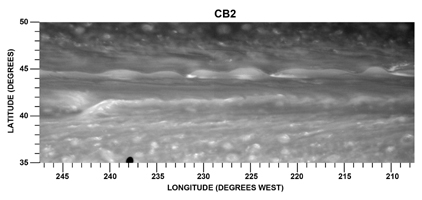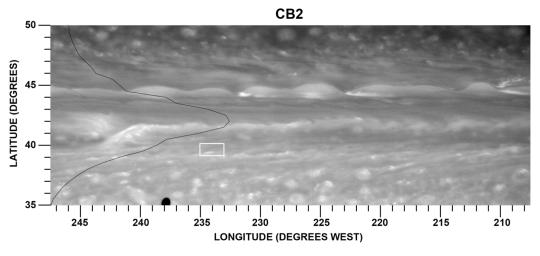
Click on the image for larger view of unannotated versionThis figure examines a particularly strong jet stream and the eddies that drive it through the atmosphere of Saturn's northern hemisphere. Data from NASA's Cassini spacecraft were used to create this figure.
This figure is a mosaic of two Cassini images taken in near-infrared light through a filter that is insensitive to methane absorption and sees through high-altitude hazes to the tops of ammonia ice clouds at deeper levels. It illustrates the typical cloud morphology within and on the flanks of an eastward jet located at about 42 degrees north latitude on Saturn.
In the annotated version of this image, the location of this jet stream is marked by the bright structure running through the horizontal center of the figure before dropping down, or south, on the left of the figure. The black line on the left of the graphic depicts the average zonal wind profile, or the wind speed measured against the latitude for the region displayed in the image. The fastest speed, measured at 42 degrees north latitude, indicates that this is the center of the eastward jet.
Jet streams churn east and west across Saturn's atmosphere, giving the gas giant its banded appearance. The jet streams are zonal, meaning they move eastward or westward at particular latitudes. In the study, scientists inferred that Saturn's internal heat and the condensation of water accelerate and power the jet streams.
Jets occur on Saturn in places where the temperature varies strongly from one location to another. When a disturbance moves warm air into a colder region or vice-versa, the disturbance can grow and create rotating wind patterns. Scientists already knew that these rotating storms, or eddies, transfer momentum to and accelerate the eastward jets like rotating gears driving a conveyor belt. In the study, scientists used an automated cloud tracking algorithm, or software, to analyze the movements and speeds of clouds seen in hundreds of Cassini images from 2005 through 2012. The white box is an example of an individual region to which the tracking algorithm was applied.
Cassini scientists have observed for the first time how these eddies accelerate the jets at two different altitudes. They found that the eddies were weak at the altitude where previous researchers had found that most of the sunlight heating occurs. The eddies were stronger, however, down deep.
The distinct clouds at the latitude of this jet stream have been visible on Saturn since the days of the Voyager spacecraft (see PIA00027). In the Voyager days, this jet stream had an undulating appearance, leading scientists to dub it the "ribbon wave" (see PIA01378). The planet's atmosphere is always changing, and the clouds at the latitude of the jet stream now look nothing like a ribbon.
See PIA14917 for a wider view of the northern hemisphere showing this wave in context.
The two images of this mosaic were taken with the Cassini spacecraft narrow-angle camera on Nov. 7, 2007 using a spectral filter sensitive to wavelengths of near-infrared light centered at 750 nanometers. The images were re-projected to a simple cylindrical map projection. The view was acquired at a distance of approximately 1.8 million miles (2.9 million kilometers) from Saturn. Image scale is 11 miles (17 kilometers) per pixel.
The Cassini-Huygens mission is a cooperative project of NASA, the European Space Agency, and the Italian Space Agency. NASA's Jet Propulsion Laboratory, Pasadena, Calif., manages the mission for NASA's Science Mission Directorate, Washington, D.C. The imaging team is based at the Space Science Institute, Boulder, Colo. JPL is a division of the California Institute of Technology, Pasadena.
For more information about the Cassini-Huygens mission visit http://saturn.jpl.nasa.gov and http://www.nasa.gov/cassini. The Cassini imaging team homepage is at http://ciclops.org.

 Planetary Data System
Planetary Data System













